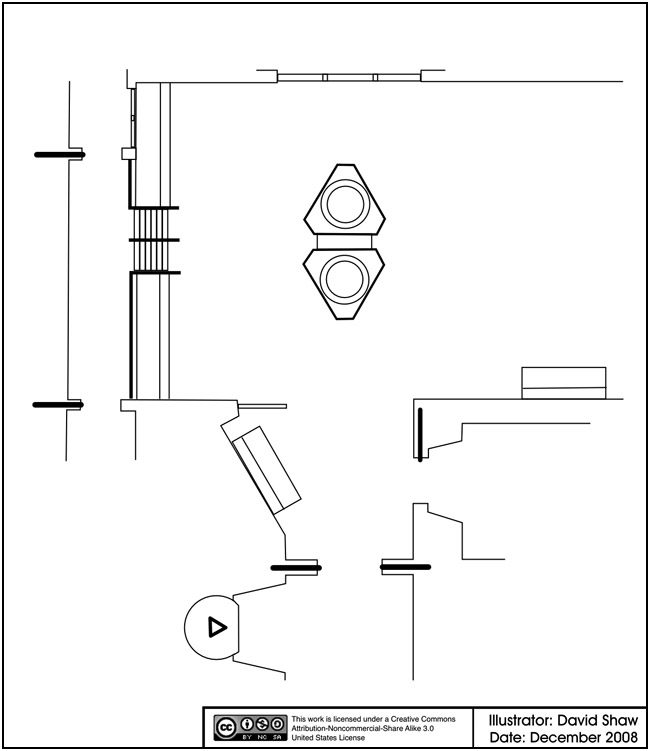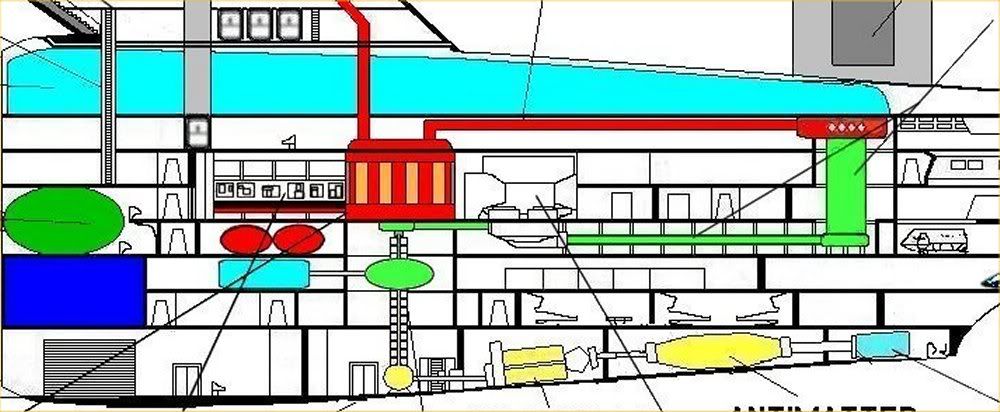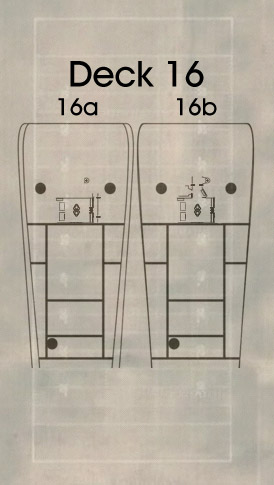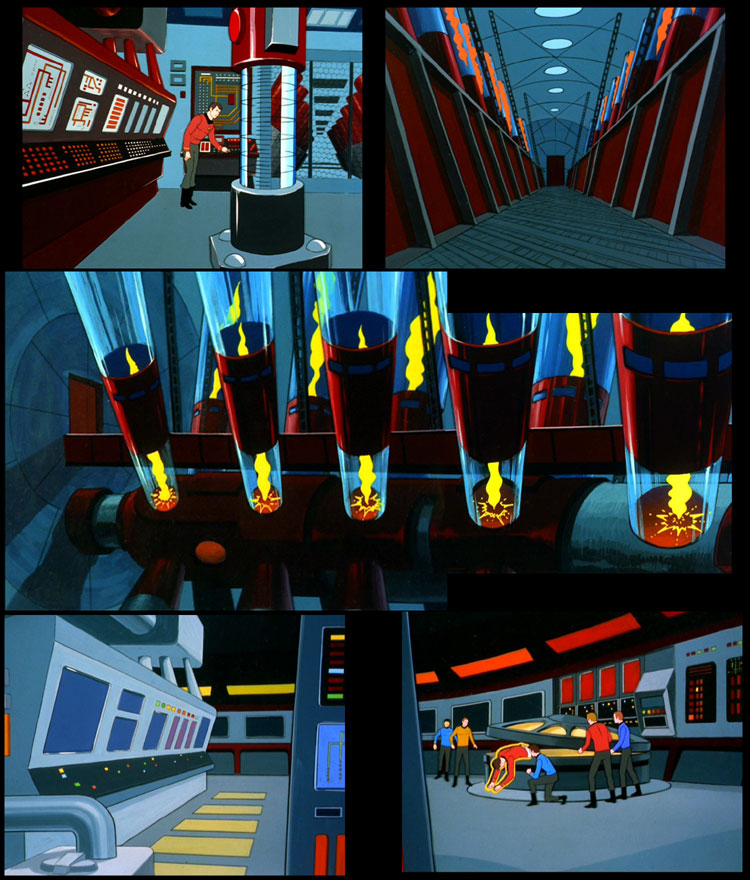I'd point out that one of the biggest issues most people face when looking at the engine room is the large "transformers". There seems to be this assumption that they need to be locked down to the floor and physically connected to something through the floor. Those are bad assumptions when we see them moved around (or missing completely) at different times.
Oddly enough it seems that people of the 21st century can't imagine what people of the later half of the 20th century could. Energy does not require
Brazil-like ductworks to be moved around in massive amounts.
Consider the Phaser Cannon from
The Cage. This was a free standing piece of equipment on the planet surface which was being powered by the Enterprise in orbit above. Not only that, it was accepting so much power that the Enterprise was being pushed to the point of overheating (which isn't all that different from what did happen to the Enterprise in
The Paradise Syndrome). And it shouldn't be that hard to imagine anyways because beaming that type of energy to some specific place is basically what the transporter does.
Now consider the M-5 computer's connection in the Engine room in
The Ultimate Computer. It was sitting on one end of the room but was powered via a port on the other end. A port which is normally inline with those two "transformers" in many episodes. Standing between that energy port and whatever is being powered by it is usually not a safety issue, but became one when the M-5 changed how the power was being beamed to it.
The other thing that many people over look is that we are talking about a spaceship... in zero gravity. The most conservative energy estimate of what it would take to create artificial gravity would be to assume that the ship has to supply whatever potential energy objects would have within the ship. And that antigravity units nullify objects from requiring that energy (in other words, when something is allowed to weigh nothing, power is saved). So moving large equipment around (like those "transformers") is actually a one person job that should take minimal effort.
So, what are those "transformer" things? My guess is that they are actually generators. And that they are used for restarting the main engines (and really only need to be arranged in series and aligned with the energy port on the wall when starting the engines). They are sort of like the starter motor of a car. If the main engines are running, then they can be moved aside or stored somewhere else completely.
Here is something to ponder... what if the Phasers, deflector and warp nacelles have
no physical connection to the main engines? Basically, no ducts, tubes or wires connecting them to main engineering.
In studying this stuff from the original series, I'm getting the idea that the technology in Trek has been working backwards (becoming less advanced as the franchise has grown) over the last 40 years. When some of the most advanced concepts (and hardest to fathom for some people) were presented in the original pilot from 1965, and I have to wonder if current Star Trek is still going to inspire it's fans the way the original series had pushed us in the past to test our own technical boundaries.
I would argue that the ship had to have far more engineering space than portrayed by any single set. That's the only way the facility could be the sort of maze where the Evil Kirk or Ben Finney could hope to hide from searches.
Main engineering is on deck 16, which is a double height deck with two levels in many areas (16a and 16b). Finney was found on b deck in main engineering.
The areas primarily dedicated to engineering on deck 16 (which I would assume to be areas not used for the hangar deck and gallery) make for a pretty large area. Below I've laid out those areas of deck 16 over a football field (to scale) to help put some perspective on this.
I would also argue that it would be a good idea to assume at least two sets' worth of space, side by side, at the forward end of that fancy pipework. This would bring symmetry to the engineering arrangements, more reasonably accommodate the curve of the ceiling, and offer space for the hiding...
Well, the curve was only on one side, having it symmetric and/or twice as wide as seen runs directly into the Emergency Manual Monitor room on Deck 16a overlooking main engineering.
Certainly the schematic view in "In a Mirror, Darkly" suggests a massive engineering "core" at the centerline of the secondary hull; the triangle of these horizontal shafts would account for that rather nicely.
Drexler's graphic had nothing (at all) to do with the original series and he is one of those people who seems to have real issues when it comes to scale or measurements (I would rather keep the designer of the
Defiant from DS9 as far away from the TOS Enterprise as possible).
I agree that trying to fit the engineering set(s) in the saucer is problematic, and perhaps we shouldn't even try. But fitting the set(s) in the secondary hull, accepting that there is a curved corridor outside the (forward) set, and then assuming that the dilithium-nursing room of "Alternative Factor" is on the other side of that corridor, would maximally preserve set continuity while fitting within the exterior shape. It is IMHO a good idea anyway to allow for curved corridors in the secondary hull, to allow for the many shots where "lower decks" feature such a curve.
The issue of straight and curved corridors is best served by ignoring them as the show was restricted to one small segment to represent everywhere.
But if you are needing that
dilithium-nursing room to be next to a curved corridor, why not use what we were given in the show itself... deck 7 (in the primary hull) is the location of the main energizers. Maybe that was what we were seeing.
In all actuality, many of the areas we know of we have a pretty good idea where they were from the show itself. Rand's quarters (on deck 12) is the only direct reference I'm considering disregarding.
I know that some people have floated the idea that the cabin numbers mean something, but I doubt it. Here are some examples...
Kirk: 3F 121
McCoy: 3F 127
Rand: 3C 46
And Kirk's quarters are known to be on deck 5.
My suggestion to everyone (and I don't see this enough from most people) is to take the sets and make them to scale with whatever size you believe the Enterprise to be, and start attempting to arrange things to match the show as best as possible. It worked for me, and I was working with the added restriction of making the sets fit into Jefferies' hull pressure compartments (most people disregard that reference completely). That type of effort shows that people are really trying to think this stuff through rather than just throwing ideas out there.




 ). The two deck instrument wall with stairs is indeed 2nd season on, IIRC, however. There were a couple of things though that I had to leave out, the most prominent being the "office space" that was partitioned off in a couple of eps where someone needed a place to hide/hide something. There was just no way to make it fit. I also had to "cheat" the right side of the room, leaving a significant amount of blank space for the spot where the M-5 could have been installed in "The Ultimate Computer".
). The two deck instrument wall with stairs is indeed 2nd season on, IIRC, however. There were a couple of things though that I had to leave out, the most prominent being the "office space" that was partitioned off in a couple of eps where someone needed a place to hide/hide something. There was just no way to make it fit. I also had to "cheat" the right side of the room, leaving a significant amount of blank space for the spot where the M-5 could have been installed in "The Ultimate Computer".



